 Engagement marketing aims to engage people. It encourages them to participate in the evolution of a brand. Customer engagement and conversations are what marketing is all about. Rather than looking at consumers as passive receivers of messages, engagement marketers believe that consumers should be actively involved in the production and co-creation of marketing programs.
Engagement marketing aims to engage people. It encourages them to participate in the evolution of a brand. Customer engagement and conversations are what marketing is all about. Rather than looking at consumers as passive receivers of messages, engagement marketers believe that consumers should be actively involved in the production and co-creation of marketing programs.
Recently I read an interesting article “Brands fail to follow rules of engagement” in Marketing Week. I was always aware of engagement marketing but I needed to dig a bit deeper to write something about it.
Engagement is a marketing approach that—in contrast to traditional brand and direct marketing strategies—allows a brand’s customers and prospects to shape the company’s marketing. People choose what messaging they will receive, and in what channels. Engagement marketing begins at the moment someone takes an action and initiates a dialogue, such as by signing up for an email program or reading a product review and requesting more information.
This is the deliberate application of strategies and tactics that drive someone toward measurable lifetime customer value and/or provide opportunities and impetus to participate in dialogues, interact with your brand, and influence others to become buyers. Ultimately, the goal of engagement marketing is to create relationships that benefit both customers and organizations.
The Engagement Mantra
Customer engagement constitutes a philosophy of brand marketing communications and customer interaction, emphasizing greater levels of collaboration in pre-sales and post-sales phases among buyers and sellers. The philosophy of customer engagement entails a primary sequence for marketing communications:
Connect with the buyer or customer on an immediate, visceral level, evoking an experience of liking or disliking someone, a group, or a thing, as well as an empathetic correspondence with a customer’s situation.
Inform the buyer or customer. Often this means demonstrating the need for a new product, a better way of doing things as compared to competitors; with success, this elicits the experience of relief—a successful result of using a featured product or service.
Entertain the buyer, using humorous, horrific, or seductive social situations; this reinforces deeper cultural narratives (shared expectations or beliefs) while dissipating any lingering fears associated with trying something new. Success in this context creates a secret or ironic insight that one must simply share!
Share directs a call to action and encourages the buyer or customer to forward a link, instant message, or sms a friend or colleague regarding a new find: “You want to check this out!” The item shared represents a currency or token of affection; that enhances one’s reputation.
The Engagement Sequence may apply to any phase of the brand marketing communication process: awareness, involvement, trial, commitment, and referral.
When implementing an engagement marketing program, make sure your platform can:
- Enable a two-way flow of customer data and communications to and from multiple marketing platforms and channels, such as email, RSS, mobile, survey and Web analytics data.
- Deploy personalized, campaign-specific microsites that re-market to visitors based on behavior factors such as how often they visited your page, clicked specific links or took a desired action.
- Generate rich transactional messages that can include important and relevant cross-sell and up-sell messaging, and that incorporate full tracking, reporting and enhanced deliverability for any message from
- any system in your organization.
- Share messages into social networks and also track downstream viral activity in order to identify your most ardent influencers.
- Send messages at times that are individually personalized for each recipient based on previous open behavior.
Today’s consumers are the most informed buyers in history. They can find out everything they want to know about a brand and the company behind it. Consumers don’t demand engagement from you, but they will be indifferent to the businesses and brands that are indifferent to them. And they will seek out relationships—knowledge-based, product-based and community-based—with the companies that they choose to do business with.
For this reason it’s about time you think about engagement marketing and include this in your mix.
Chintan is the Founder and Editor of Loyalty & Customers.






7 Trackbacks / Pingbacks
Comments are closed.